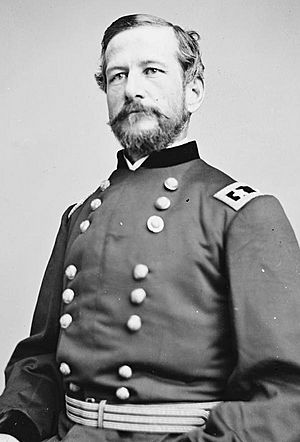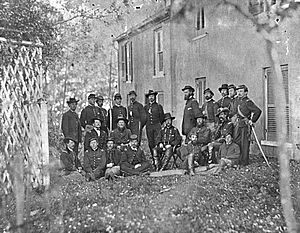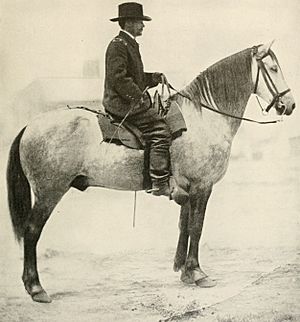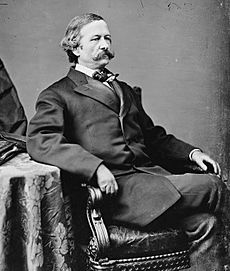Alfred Pleasonton facts for kids
Quick facts for kids
Alfred Pleasonton
|
|
|---|---|

Alfred Pleasonton, portrait by Mathew Brady
|
|
| 6th Commissioner of Internal Revenue | |
| In office January 3, 1871 – August 8, 1871 |
|
| President | Ulysses S. Grant |
| Preceded by | Columbus Delano |
| Succeeded by | John Watkinson Douglass |
| Personal details | |
| Born | June 7, 1824 Washington, D.C. |
| Died | February 17, 1897 (aged 72) Washington, D.C. |
| Resting place | Congressional Cemetery |
| Military service | |
| Allegiance | United States of America Union |
| Branch/service | United States Army Union Army |
| Years of service | 1844–1868 |
| Rank | |
| Commands | Cavalry Corps |
| Battles/wars | Mexican–American War American Civil War |
Alfred Pleasonton (born June 7, 1824 – died February 17, 1897) was an important officer in the United States Army. He became a major general of volunteers in the Union cavalry during the American Civil War. He led the Cavalry Corps of the Army of the Potomac during the Gettysburg campaign. This included the Battle of Brandy Station, which was the biggest cavalry battle of the war.
In 1864, he moved to the Trans-Mississippi theater. There, he defeated Confederate General Sterling Price in two key battles. These included the Battle of Mine Creek, the second largest cavalry battle of the war. His actions helped end the war in Missouri.
Contents
Early Life and Military Beginnings
Alfred Pleasonton was born in Washington, D.C., on June 7, 1824. His father, Stephen Pleasonton, was famous for saving important documents. During the War of 1812, he protected the original Declaration of Independence and the U.S. Constitution from British invaders.
Alfred's older brother, Augustus, also went to the United States Military Academy. This likely influenced Alfred's choice to join the military. Alfred graduated from West Point on July 1, 1844. He became a second lieutenant in the 1st U.S. Dragoons, which was a type of heavy cavalry.
He served on the frontier in places like Minnesota, Iowa, and Texas. He fought in the Mexican–American War. He was recognized for his bravery in battles like Palo Alto and Resaca de la Palma in Texas. He was promoted to captain on March 3, 1855.
Civil War Service
When the Civil War began in 1861, Captain Pleasonton was with his unit in Utah. He moved to Washington D.C. He worked hard to get promoted, using his father's old connections. He became a major on February 15, 1862.
He took part in the Peninsula campaign. Later, President Abraham Lincoln nominated him for promotion to brigadier general of volunteers. This appointment was confirmed on July 16, 1862. After this, he led a brigade of cavalry in the Army of the Potomac.

From Peninsula to Chancellorsville
On September 2, 1862, Pleasonton took command of a cavalry division. His job included gathering information about the enemy. During the Maryland campaign, he was responsible for estimating the strength of the Confederate forces. However, his estimates were often wrong. This led Union General George McClellan to believe the Confederates had more soldiers than they actually did.
Pleasonton was injured in his right ear at the Battle of Antietam on September 17. He felt he deserved to be promoted to major general for his actions. He claimed his cavalry and artillery had a big impact on the battle. He did receive a brevet promotion to lieutenant colonel in the regular army.
At the Battle of Chancellorsville, Pleasonton again tried to highlight his own importance. He claimed he stopped an attack by Stonewall Jackson's troops. He also said he prevented the complete defeat of the Union XI Corps. He was so convincing that General Joseph Hooker, the army commander, told President Lincoln that Pleasonton "saved the Union Army." However, other reports show his role was much smaller.
Despite this, his claims helped him get promoted. He was appointed major general of volunteers on June 22, 1863. When the cavalry corps commander was removed, Hooker named Pleasonton as his temporary replacement.
Leading Cavalry at Gettysburg
Pleasonton's first major battle in his new role was during the Gettysburg campaign. He led Union cavalry at the Battle of Brandy Station. This was the largest cavalry battle of the war. The Union cavalry surprised J. E. B. Stuart's Confederate cavalry. The battle was long and bloody, but it didn't have a clear winner. However, Union cavalry gained new confidence.
During the rest of the Gettysburg Campaign, Pleasonton struggled to keep track of enemy movements. General Robert E. Lee's Confederate army managed to move north into Pennsylvania without the Union army knowing their exact location. Pleasonton also used his political connections to promote some of his staff members. These included Captain Elon J. Farnsworth and First Lieutenant George Armstrong Custer, who both became brigadier generals.
Pleasonton also worked to get more cavalry forces for his command. These actions angered General Hooker. However, Hooker himself was replaced as army commander on June 28, 1863. This likely saved Pleasonton's career.
At the Battle of Gettysburg, Pleasonton's new commander, General George Meade, kept him close. Meade made Pleasonton stay at army headquarters. He took more direct control of the cavalry than usual. After the war, Pleasonton claimed he played a major role in the battle. He said he predicted Gettysburg would be the key point. He also claimed he urged Meade to attack Lee after the Confederate defeat in Pickett's Charge. These claims were made after Meade's death, so they could not be challenged.

Success in the West
Pleasonton was later moved to the Trans-Mississippi Theater. He commanded military districts in Missouri starting July 4, 1864. He performed very well there. Over four days, he defeated General Sterling Price in several battles. These included the Battle of Byram's Ford, the Battle of Mine Creek, and the Marais des Cygnes. These victories ended the last major Confederate threat in the West.
After the war, he was nominated for honorary promotions in the regular army. He became a brevet brigadier general and then a brevet major general.
After the War
After the Civil War, Pleasonton left the volunteer service. He was a major in the regular army. He didn't want to leave the cavalry. He turned down a promotion in the infantry. He became unhappy with his rank, as he once outranked many officers. He resigned from the army in 1868. He was later placed on the Army's retired list as a major in 1888.
As a civilian, he worked for the government. He was the United States Collector of Internal Revenue. He also served as Commissioner of Internal Revenue under President Ulysses S. Grant. However, he was asked to leave this job. He had argued with his bosses and pushed for changes in tax laws. He refused to resign and was eventually dismissed. He also briefly served as president of a railroad company.
In 1895, Pleasonton claimed he had been offered command of the Army of the Potomac. He said he refused because he didn't agree with the conditions. He claimed the conditions were that the war must not end until the South was "crushed," slavery was abolished, and President Lincoln was reelected. Pleasonton said he only wanted to defeat the South's military, not to "crush" them or force other changes. However, historians are very doubtful about this claim.
Alfred Pleasonton passed away in his sleep in Washington, D.C., on January 17, 1897. He is buried in the Congressional Cemetery next to his father. Before he died, he asked for his funeral to have no military honors. He even refused to be buried in his old uniform. He felt the Army had overlooked him after the Civil War.
The town of Pleasanton, California, was named after Alfred in the late 1860s. A mistake by a postal worker led to the different spelling. The city of Pleasanton, Kansas, is also named for him. A statue of General Pleasonton stands on the Pennsylvania Memorial at the Gettysburg Battlefield. Some believe this statue might actually be of his brother, Augustus.
See Also
 In Spanish: Alfred Pleasonton para niños
In Spanish: Alfred Pleasonton para niños
- List of American Civil War generals (Union)



